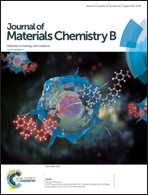A self-immolative and DT-diaphorase-activatable prodrug for drug-release tracking and therapy†
Abstract
DT-diaphorase, which catalyzes the reduction of various biological substances like quinones, is overexpressed in some malignant tumors. However, exploiting this attractive property for the controlled release of an active drug from a prodrug is yet to be fully taken advantage of. Herein we report a DT-diaphorase-based prodrug for concomitant drug-release imaging and cancer chemotherapy. This prodrug system is composed of two camptothecin (CPT) moieties as the active anticancer drug, a DT-diaphorase-responsive quinone propionic acid moiety and a set of self-immolative linkers. The presence of DT-diaphorase leads to the release of two CPT molecules and restores the fluorescence of the latter, thereby realizing the fluorescence monitoring of the DT-diaphorase level as well as the tracking of CPT release. Upon internalization by DT-diaphorase overexpressing cells, the prodrug can release fluorescent CPT and exhibit high cytotoxicity (half-maximal inhibitory concentration 0.71 μM) towards the cancer cells. This prodrug features on-demand enzyme-biomarker-triggered drug release as well as self-monitoring of drug release, therapeutic effect and biomarker level. This new strategy may provide an effective approach for constructing prodrugs with enhanced drug loading as well as controllability for drug release and tracking.



 Please wait while we load your content...
Please wait while we load your content...